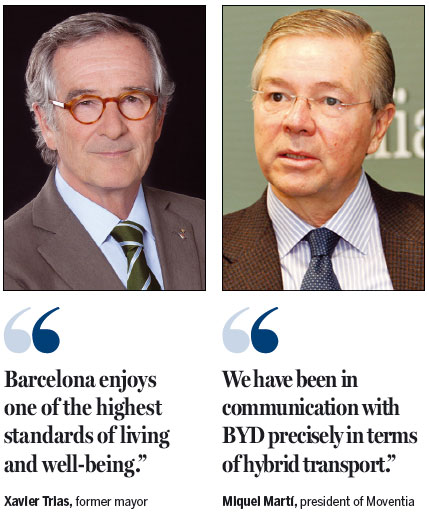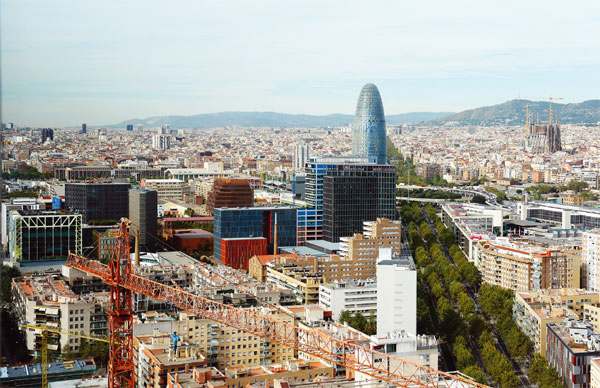Barcelona continues to grow at speed
|
Barcelona is a smart city that both embraces and pioneers change. Provided to China Daily |

City combines innovation, investment and sustainability to stay ahead of the crowd
Things just keep getting better in the vibrant city of Barcelona, the capital of Catalonia that is arguably Spain's most dynamic autonomous community. Since it hosted the Olympics in 1992, the city of 1.6 million people has grown in stature, wealth and sophistication to become one of the world's most popular business and tourism destinations.
Situated on the Mediterranean coast, just under 1.5 hours by highspeed train from France, and with the busiest port in the region, Barcelona stands head and shoulders above many other European and international cities, thanks to its world-class infrastructure, open and business-friendly outlook, and work and lifestyle balance.
Despite covering only 6 percent of Spain's territory and having 16 percent of its population, Catalonia still represents 20 percent of Spain's gross domestic product, 26 percent of exports, 26 percent of tourism and 26-27 percent of imports.
As Spain and the rest of Europe undergo austerity measures to balance the books, Barcelona is taking clear steps to confront the widespread debt crisis affecting Europe.
"The first one is to never again have a deficit - we have been able to greatly reduce Barcelona's debt without the necessity to increase taxes and, at the same time, we are able to create savings, which allows us to have the ability to invest each year around 400-500 million euros ($437-547 million)," said Xavier Trias, who was the city's mayor until May.
"We want to manifest that we are serious and solvent in order to distinguish ourselves from other public administrations in Spain, and this is why we make it a point of paying all of our financial commitments within 30 days. Moreover, we have been able to reduce unemployment to 15-16 percent, whereas it used to be 22 percent."
The city has also benefited greatly from Chinese investment. Since 2000, about 4 billion euros has been pumped into the port - 50 percent of which is private funding.
Chinese conglomerate Hutchison Port Holdings has taken one of the most significant roles in transforming the port and maritime commerce of Barcelona to become the hub of the Mediterranean for both cargo and passenger liners.
The Barcelona Europe South Terminal, which opened in 2012, became the first semi-automated container terminal thanks to HPH. BEST currently has 11 super post-Panamax quay cranes, 36 automatic stacking cranes and 26 shuttle carriers operating along a 1,000-meter-long berth with a draft of 16.5 meters.
Since its official opening in September 2012, BEST has provided excellent yields, with a vessel operating rate surpassing 220 moves per hour and an annual average gross crane rate surpassing 40 moves per hour, one of the highest rates of productivity in Europe.
The terminal has one of the most modern entry/exit gate complexes in Europe and one of the largest rail terminals at a container port with an eight-track railway facility with mixed Iberian and UIC gauges, connecting BEST daily to many destinations in Spain and Southern Europe.
Barcelona is also a must-see for a growing number of Chinese tourists. Spain currently receives 10 percent of Chinese visitors to Europe, with Catalonia welcoming approximately 70 percent of these travelers. Despite this, the Trias administration was keen to raise the city's status to much more than a mere tourist attraction.
"Our goal is to be known as a city of culture, of knowledge, of creativity and innovation," said Trias. "And the key point is that Barcelona enjoys one of the highest standards of living and well-being, which makes it especially attractive for people to come to work and live here."
Innovation, sustainability
Barcelona is undoubtedly one of the most entrepreneurial, creative and innovative cities in the world and it positions itself as a very attractive city for Chinese investors.
"We are taking the leading role of being a 'smart city' - Barcelona is the fourth-largest of these in the world - it's a 'hand-held' city, as well as a sustainable and water-efficient city. It is not enough that the government utilizes these new technologies; we are betting heavily that the citizens and tourists can use and take advantage of these technological advancements," Trias said.
Santi Vila, former minister of territory and sustainability at the Catalonian government, added: "Barcelona's model of success is based on the three Cs: It is an urban model that is very compact - whenever possible it grows tall, not wide. It is a model with a highly complex mix of uses and activities. It is cohesive as there are plenty of activities, amenities and open spaces devoted to each neighborhood, so there are few overtly 'rich' or 'poor' areas.
"For this model of three Cs to work, you need to have some guarantees, such as public transport and sustainable mobility services. The success of the city is reflected in the correct relationship between public space and buildings for economic and residential activity."
An example of this is Moventia - a private, family-owned company that operates buses for private and public use and is dedicated to the easy movement of people and goods, as its slogan "always in motion" implies.
It is also a distributor of nine automotive brands at present, including Mercedes-Benz, Smart, SEAT, Audi, Volkswagen, Skoda, Renault and scooter group Piaggio.
"We have to break away from the basic scheme of mass transport, whether it is public or private," said Miquel Mart??, president of Moventia. "Our task now is to become specialists in mobility. The concept of transport is already taken care of. Today's society demands mobility. Sometimes you can solve it with private transportation, and sometimes with public transport.
"The commitment to sustainability has become essential, therefore the more you bet on the sustainability of a system, especially in large conurbations, the more the commitment should be directed to recurrent trips, by having a greater capacity of supply and response to the mass mobility.
"We'll hardly meet the environmental needs of the metropolitan cities without first potentiating public transport. Not only within the public transport concept but also the type of transport and technical specifications that public transport should incorporate, and so we need to enter the topic of new technologies like hybrid and natural gas and liquid gas. There is therefore an important road to be taken by us bus manufacturers to bet on a technology that is cleaner, especially with regulations in Europe and the Euro 6, required in public transport, such as CO2 emissions, and particulate emissions to be almost reduced to zero," Mart?? said.
"Catalonia has been a technological pioneer in its responsiveness to this topic in Barcelona and its metropolitan area, where 55 percent of trips made are by mechanical public transportation such as bus, subway, and Renfe, Spain's national train operator. If less than 55 percent of the city were moved by private transport, Barcelona would come to a standstill and it would be impossible environmentally."
Despite the influx of foreign direct investment into Barcelona in recent years, there are many more investment opportunities.
In the short term, government officials would like to see investments in water infrastructure, as well as acquisition and rehabilitation of historic city centers and home renovations. Businesses related to logistics and infrastructure services, such as waste or extensions of the metro network, are ideal multimillion investments for foreign funds seeking big projects.
"We have been in communication with (China's automaker) BYD precisely in terms of hybrid transport," Mart?? said. "Until now the technology did not allow use for enough hours to avoid having to remove the bus.
"We are getting closer to 12-13 hours of service provided by a bus, but are still a bit short of the 16 hours they are in operation. There were two factors that did not make this technology a reality - the ability of the technology and the cost ratio. This gap is closing more and more, and we look forward to collaborating with Chinese technology companies," he said.
Healthy opportunities
Huge leaps in health innovations are also being made in Barcelona.
The Puigvert Foundation is one such example. Set in the grounds of one of the city's most iconic hospitals, Hospital de St Pau, the foundation is a highly specialized hospital that conducts diagnostics and treatment of diseases and disorders affecting the kidneys and urinary tract of both men and women of all ages with technologically advanced and proven methods of treatment - clinical, surgical or non invasive medical technologies.
The hospital also specializes in treating diseases and disorders of the glands and organs of the male genitalia, that are involved in sexual and reproductive well-being.
The hospital has state-of-the-art facilities that employ more than 700 professionals, creating integrated and multidisciplinary teams that in addition to ensuring highly specialized treatment of diseases, maintain a holistic perspective on patients and their medical care and support.
The foundation serves more than 8,000 new patients each year, making it Europe's busiest and therefore most experienced hospital in its areas of specialization.
It is committed to minimally invasive surgery ranging from endoscopy to extracorporeal shock wave lithotripsy to break up kidney stones, laparoscopy and medical robotics. It addresses chronic kidney disease from prevention to leading replacement therapy and renal transplantation. It treats prevalent kidney diseases as well as less common glomerular or hereditary diseases. In the field of assisted reproduction and sexual activity, the hospital takes an integrated approach and pays attention to complex processes, both clinical and surgical.
InFocus provided this story.
(China Daily 07/28/2015 page15)















